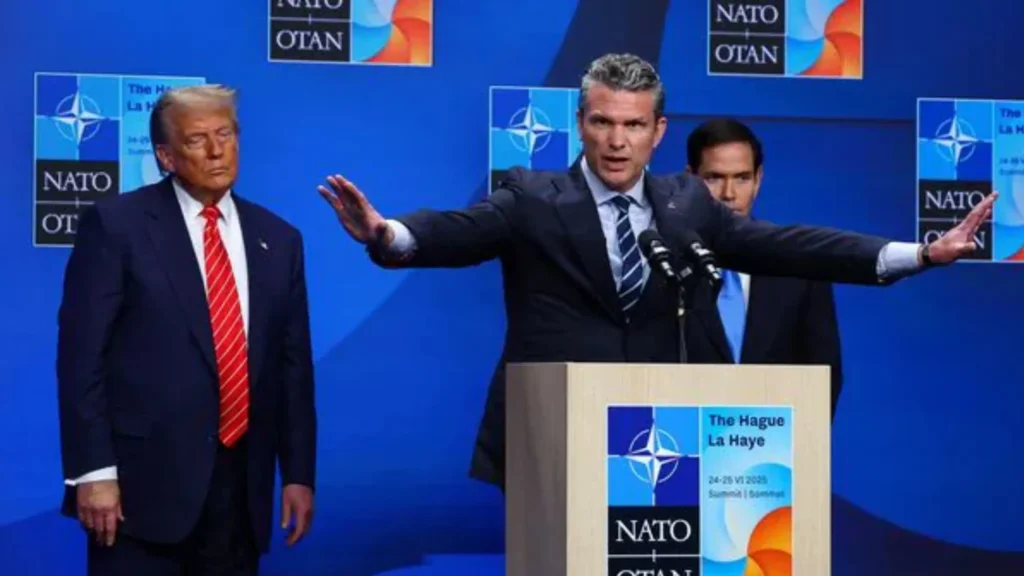Washington, D.C. — U.S. Defense Secretary Pete Hegseth said on Thursday that there is no known intelligence suggesting Iran moved its highly enriched uranium stockpile ahead of recent U.S. airstrikes (Defense Chief), pushing back against speculation that Tehran had safeguarded its nuclear assets prior to the attack.
Background on the Strikes
On Sunday, U.S. bombers targeted three Iranian nuclear facilities with more than a dozen 30,000-pound bunker-buster bombs. The strikes followed President Donald Trump’s announcement that Iran’s nuclear program had been “obliterated” — a claim now being scrutinized by intelligence sources and experts.
No Intel on Uranium Movement, Says Pentagon
“I’m not aware of any intelligence suggesting things were moved or were not where they were supposed to be (Defense Chief),” Hegseth told reporters during a tense press briefing. Trump backed him up, stating via social media that vehicles seen at the sites were only involved in construction, not removal efforts.
Conflicting Reports from Experts
Despite these claims, some nuclear experts and satellite imagery analysts argue otherwise:
- Satellite data from Maxar Technologies revealed unusual vehicle activity near the Fordow facility shortly before the attacks.
- A senior Iranian source told Reuters that most of Iran’s 60% enriched uranium was moved to an undisclosed location.
- The Financial Times, citing European intelligence, said Iran’s uranium stockpile remains largely intact since it was not concentrated at the Fordow site.
Mixed Intelligence Assessments
Earlier reports from the Defense Intelligence Agency suggested the strikes may have delayed Iran’s program by only a few months. Hegseth dismissed these as “low-confidence” assessments, saying updated intelligence now shows the nuclear program was severely damaged and could take years to recover.
CIA Director John Ratcliffe echoed this sentiment in a closed Senate briefing attended by Hegseth, Secretary of State Marco Rubio, and Joint Chiefs Chair General Dan Caine.
“It was not part of the mission to destroy or seize all the uranium,” said Senator Tom Cotton after the briefing.
Senator Mark Warner noted (Defense Chief), “Some enriched uranium was never going to be destroyed by bombs buried underground. Inspectors on the ground are needed to truly know the extent.”
Response from Iran and Political Fallout
Iran’s Supreme Leader Ayatollah Ali Khamenei declared the war a victory for Iran and warned of retaliation if the U.S. launched further attacks. Iran claims over 600 of its citizens were killed during the conflict. In response, Iran’s missile barrages reportedly killed 28 people in Israel.
Meanwhile, the U.S. Senate is expected to vote on a resolution requiring congressional approval for future strikes on Iran — though it is unlikely to pass.
Hegseth Slams Media, Trump Applauds
During the press conference, Hegseth accused the media of downplaying the military’s success due to anti-Trump bias, stating, “Because of the hatred of this press corps, so many heroic actions are being overlooked.” Trump later praised Hegseth’s remarks on social media as “one of the greatest and most professional news conferences ever.”
General Dan Caine, who also spoke at the briefing, presented technical details and testing footage of the bombs used in the strike. He emphasized his role remains apolitical and said he has never been pressured to alter assessments to align with political narratives.
“I’ve never been pressured to say anything except what I believe is accurate,” Caine stated firmly.
Source: Reuters
Read More : Treasury Chief Seeks End to ‘Retaliatory’ Tax Amid GOP Rift .
